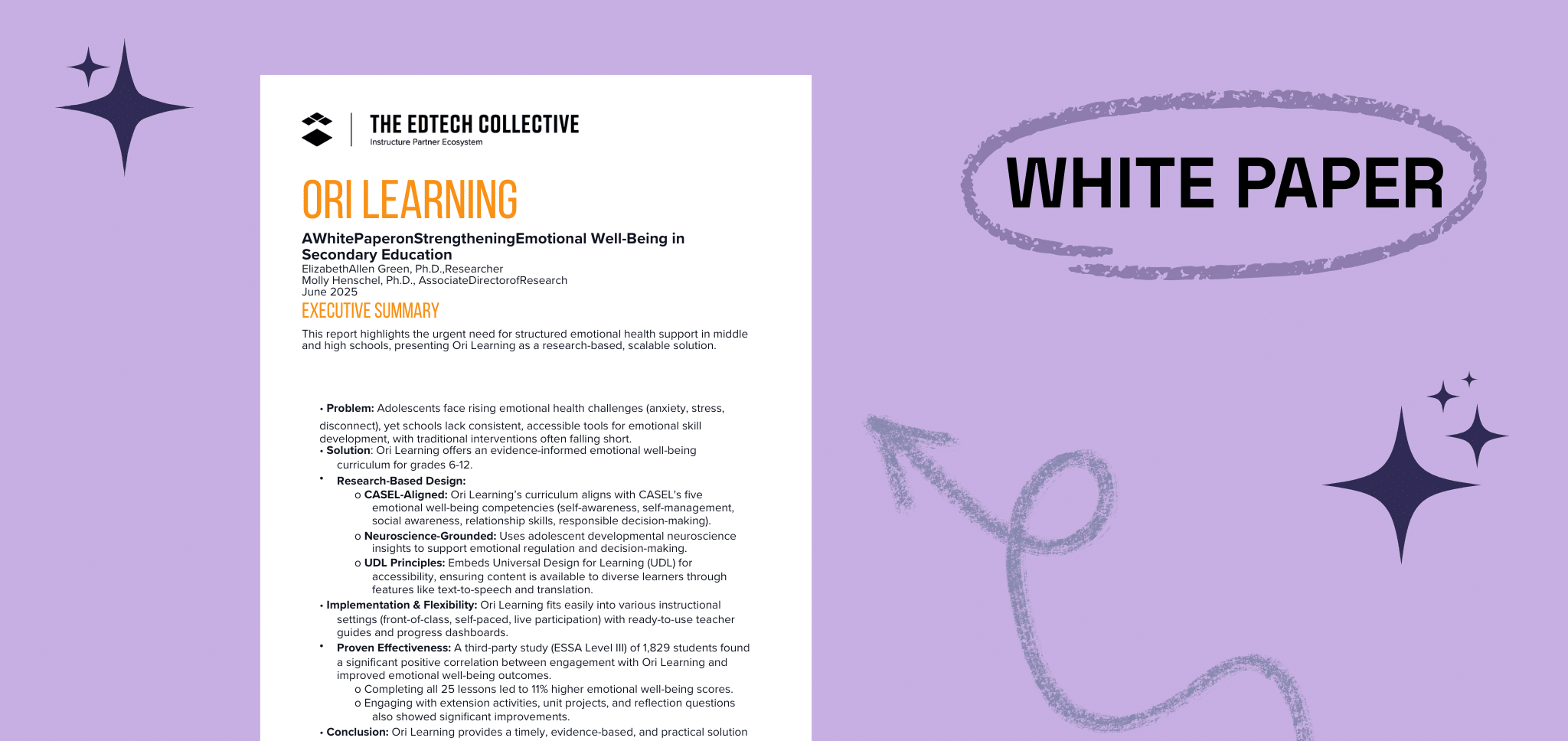
What is SEL’s Role in Preventing Teacher Burnout & Improving Student Outcomes?


Research consistently shows that students receiving explicit social-emotional learning (or SEL) instruction score higher on tests, exhibit fewer disciplinary issues, and derive other long-term benefits. At the same time, SEL practices can help improve teacher well-being, reducing burnout and churn. It is no surprise, then, that the return on investment for SEL has been estimated at $11 for every dollar spent.
In this overview, we will explore these and other key benefits of SEL for your school or district. We will review the latest research and data on the effectiveness of such programs and propose strategies for implementing SEL effectively while preserving the wellbeing of those responsible for its implementation: school staff.
More than two decades of meta-analyses corroborate that SEL interventions significantly bolster social-emotional competencies and long-term academic outcomes, alongside improved behavioral functioning and mental health. Students participating in SEL programs are in general more engaged and attentive at school, demonstrating a better attitude towards their studies. Moreover, such students are on average 11% more successful academically.
Most recently Cipriano et al. have reaffirmed the effectiveness of such programs by sampling 423 studies involving over 500,000 students. One of the key findings of Cipriano’s analysis is the effects of SEL on students’ perceptions of safety and inclusion at school. The study demonstrates close links between SEL and social awareness, leading to healthier, safer school climates. Moreover, students who benefit from instruction in this area regularly report lower levels of anxiety, stress and depression.
Unlike other short-term solutions, SEL’s impact remains even after formal instruction ends. For instance, a University of Chicago study found that high schools emphasizing SEL had higher graduation rates, more graduates going on to attend college and less school-based arrests. Combined with the improved academic performance of students, safer school climate and reduced behavioral problems these long-term effects add to the substantial ROI that schools and districts often see when they invest in SEL.
Dive deeper into the data behind successful SEL curricula and how they can have a long-lasting impact on student outcomes.

The ROI of SEL programs becomes even more apparent when we take into consideration the knock-on effects they can have on educator well-being.
The demands of the modern classroom can be overwhelming. Between grading, lesson planning, and managing classroom dynamics, burnout is a genuine concern. Recent research has shown that SEL practices can provide educators with mechanisms to better navigate the professional challenges, thereby reducing burnout and attrition rates among teachers. Moreover, a case outlined in a recent Wallace Foundation report demonstrated that staff burnout and turnover decreased noticeably when time was dedicated to SEL, with the percentage of staff reporting burnout dropping from 62% to 29%, and turnover rate dropping from 33% to 23%. Mindfulness-Based Interventions (MBIs), often combined with yoga or Cognitive Behavioural Therapy (CBT), have been identified as popular and effective stress-reduction interventions for educators.
A classroom where every student feels valued is more harmonious and productive. SEL helps in creating this nurturing atmosphere by fostering responsive classroom environments that build supportive relationships, which in turn prevent isolation and disengagement among students.
Emotionally safe learning environments, where students feel secure expressing themselves and taking on challenges, can be achieved by making SEL an integral part of the school culture. Moreover, as CASEL themselves point out, a school climate that promotes all students’ social and emotional learning is a hallmark of a trauma-sensitive school.
Our schools and districts are a melting pot of cultures, backgrounds, and experiences. SEL offers the tools to bridge the gaps of misunderstanding and create a more unified classroom. Creating classrooms centered around caring, kindness, and self-reflection can foster a strong school culture of inclusivity. Such a culture can be cultivated by encouraging teachers to focus on students’ assets, strengths, and cultural backgrounds. Additionally, creating a classroom environment where students are encouraged to self-reflect, celebrate their identities, and support one another also fosters a culture of caring.
Get the best return on your SEL investment with Ori Learning
If you would like to support the implementation of SEL programs at your school or district, here are some actionable steps you can take to achieve this:
Policy review and alignment: Conduct a thorough review of existing policies to ensure they are in alignment with SEL principles. Where necessary, advocate for policy adjustments or the formulation of new policies that support SEL implementation.
Funding allocation: Secure sufficient funding for SEL programs, ensuring resources are available for training, materials, and evaluation. The sustainable funding could be sourced from federal grants, state allocations, or private foundations.
Capacity building: Offer robust professional development programs to equip educators with the requisite knowledge and skills for effective SEL instruction. This could include training on mindfulness practices, conflict resolution, and culturally responsive teaching.
Ongoing support: Provide ongoing support and mentoring for educators, creating a community of practice that encourages sharing of insights and experiences in SEL implementation.
Parental involvement: Engage parents and guardians in the SEL process by providing them with information on the benefits of SEL and how they can support their children’s social and emotional development.
Partnerships with local organizations: Establish partnerships with local community organizations to support SEL initiatives, thereby creating a cohesive support system for students.
Data collection and analysis: Collect and analyze data on the impact of SEL programs on student and teacher outcomes. Utilize this data to identify areas of improvement and celebrate successes.
Feedback loops: Establish feedback mechanisms with all stakeholders to continuously refine and enhance the SEL programs.
Visibility and communication: Promote SEL across the school or district through regular communications, highlighting the benefits and successes of SEL initiatives.
Integrating SEL across curricula: Ensure that SEL principles are integrated across all subject areas and grade levels, fostering a school-wide culture of social-emotional learning.
In the demanding world of special education, burnout is an unfortunate and pervasive reality, impacting both staff wellbeing and student success. This free infographic, tailored specifically for current and aspiring special education leaders, presents a crucial resource in the fight against burnout at every level.

Common physical symptoms of burnout are fatigue, headaches, and insomnia, while the emotional symptoms typically encompass feelings of incompetence or ineffectiveness, irritability, anxiety, and even depression.
If left untreated, teacher burnout may even lead to chronic mental and physical health concerns for the individual in the long term. It can even go as far as to cause teachers to become reactive and lash out at their students verbally or physically.
Teachers can recover from burnout through support, self-care, and timely interventions that address root causes and focus on prevention. Professional counseling, workload adjustments, and a supportive environment contribute to recovery.
The first step towards unlocking the multiple benefits of SEL is to choose the optimal curriculum. Ori Learning’s SEL curriculum empowers educators to deliver essential social and emotional skill instruction with confidence and minimal training required for staff. Our platform is intuitive and easy to use and comes packed with powerful progress monitoring tools, as well as translation and accommodations features that support diverse learning needs. Developed using the UDL framework, the curriculum gradually builds upon and reinforces key skills with age-appropriate content that engages and inspires students throughout their learning journey.